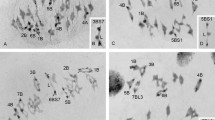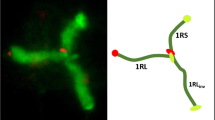Abstract
In maize microsporocytes Heterozygous for a chromosome 2 interchange chromosome (which carries a homoeologous Tripsacum chromosome segment substituted for the distal half of its short arm), normal synapsis usually occurs at pachytene throughout the bivalent, but crossing over is almost entirely restricted to the homologous proximal region of the arm, (where it apprently occurs frequently). At diakinesis chiasmata were very often found to be located immediately proximal to an easily observable terminal knob of the Tripscacum chromosome segment. It was concluded that chiasmata, initiated in the homologous proximal region, had been maintained while terminalizing across the homoeologous region. It was also noted that heterozygosity for a telomere (and distal region) foreign to maize does not seem to inhibit pairing effective for crossing over in the homologous proximal portion of the chromosome arm.
Similar content being viewed by others
References
Fu, T.K., Sears, E.R.: The relationship between chiasmata and crossing over in Triticum aestivum. Genetics 75, 231–246 (1973)
Jones, G.H.: The analysis of exchanges in tritium labelled meiotic chromosomes II. Stethophyma grossum. Chromosoma (Berl.) 34, 377–382 (1971)
Jones, G.H.: Giemsa C-banding of rye meiotic chromosomes and the nature of “terminal” chiasmata. Chromosoma (Berl.) 66, 45–57 (1978)
Kanda, N., Kato, H.: Analysis of crossing over in mouse meiotic cells by BrdU labelling technique. Chromosoma (Berl.) 78, 113–121 (1980)
Loidl, J.C.: C-band proximity of chiasmata and absence of terminalization in Allium flavum (Liliaceae). Chromosoma (Berl.) 73, 45–51 (1979)
Maguire, M.P.: A study of pachytene chromosome pairing in a corn-Tripsacum hybrid derivative. Genetics 45, 651–664 (1960a)
Maguire, M.P.: A study of homology between a terminal portion of Zea chromosome 2 and a segment derived from Tripsacum. Genetics 45, 195–209 (1960b)
Maguire, M.P.: Common loci in corn and Tripsacum. J. Hered. 53, 87–88 (1962)
Maguire, M.P.: The relationship of crossover frequency to synaptic extent at pachytene in maize. Genetics 51, 23–40 (1965)
Maguire, M.P.: The effect of synaptic partner change on crossover frequency in adjacent regions of a trivalent. Genetics 59, 281–290 (1968)
Maguire, M.P.: Evidence for separate genetic control of crossing over and chiasma maintenance in maize. Chromosoma (Berl.) 65, 173–183 (1978a)
Maguire, M.P.: A possible role for the synaptonemal complex in chiasma maintenance. Exp. Cell Res. 112, 297–308 (1978b)
Maguire, M.P.: An indirect test for a role of the synaptonemal complex in the establishment of sister chromatid cohesiveness. Chromosoma (Berl.) 70, 313–321 (1979a)
Maguire, M.P.: Direct cytological evidence for true terminalization of chiasmata in maize. Chromosoma (Berl.) 71, 283–287 (1979b)
Maguire, M.P.: Adaptive advantage for chiasma interference: A novel suggestion. Heredity 45, 127–131 (1980)
Mascarello, J.T.: Meiotic chromosomes of antelope squirrels. Cytogenet. Cell Genet. 26, 104–107 (1980)
Moens, P.B., Church K.: The distribution of synaptonemal complex material in metaphase I bivalents of Locusta and Chloealtis (Orthoptera: Acrididae). Chromosoma (Berl.) 73, 247–254 (1979)
Peacock, W.J.: Replication, recombination and chiasmata in Goniaea australasiae (Orthoptera: Acrididae). Genetics 65, 593–617 (1970)
Rhoades, M.M.: Studies on the cytological basis of crossing over. In: Replication and recombination of genetic material (W.J. Peacock and R.D. Brock, eds.), p. 229–241. Canberra: Australian Acad. Science 1968
Rhoades, M.M.: Genetic effects of heterochromatin in maize. In: Maize breeding and genetics (D.B. Waiden, ed.), p. 641–671. New York, Chichester, Brisbane, Toronto: John Wiley and Sons 1978
Santos, J.L., Giraldez, R.: The effect of C-heterochromatin in chiasma terminalization in Chorthippus biguttulus L. (Acrididae, Orthoptera). Chromosoma (Berl.) 70, 59–66 (1978)
Schwartz, D.: The behavior of an X-ray-induced ring chromosome in maize. Amer. Naturalist 87, 19–28 (1953)
Swanson, C.P.: Cytology and cytogenetics, pp. 1–596. Englewood Cliffs, N.J.: Prentice-Hall, Inc. 1957
Tease, C.: Cytological detection of crossing-over in BUdR substituted meiotic chromosomes using the fluorescent plus Giemsa technique. Nature (Lond). 272, 823–824 (1978)
Author information
Authors and Affiliations
Rights and permissions
About this article
Cite this article
Maguire, M.P. Chiasma maintenance and terminalization across a homoeologous bivalent segment. Chromosoma 82, 107–112 (1981). https://doi.org/10.1007/BF00285753
Received:
Accepted:
Issue Date:
DOI: https://doi.org/10.1007/BF00285753




